Ancient Imitations of Roman Coins of the Period of Constantine (307-337)
This site has six pages, including pages on the very common GLORIA EXERCITVS, VRBS ROMA, and CONSTANTINOPOLIS types (330-340, epidemic imitations commonly found in the West, especially Britain), a page on the common "Two-Victories" type (epidemic imitations most commonly found in the Balkans and to the north), and this page, which is on endemic imitations of all other types of Constantine and his relatives, to AD 340. A short page on imitations of types 340-348 concludes this group of pages.
On this page: Coins of Constantine and family: BEATA TRANQVILITAS (first), VOT XX, campgate, VIRTVS EXERCITI,
followed by types of Crispus (Vota), Helena (PAX), and Constantine II.
Constantine (307 - 337)
BEATA TRANQVILLITAS imitations
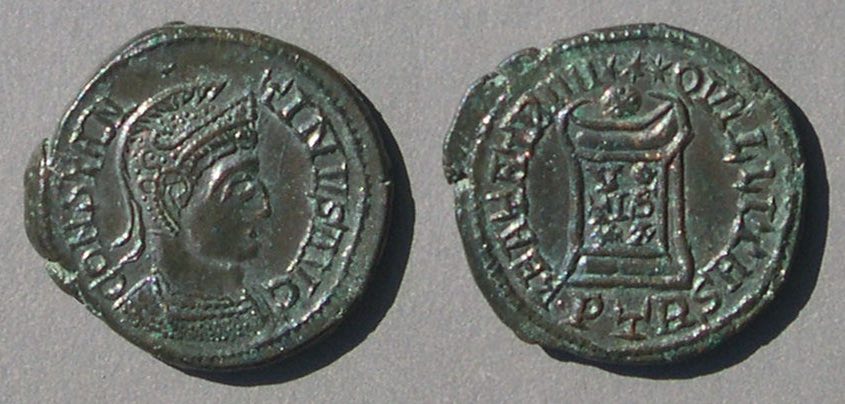 A wonderful full-sized imitation
A wonderful full-sized imitation
19 mm. 4.43 grams.
CONSTANTINVS AVG, helmeted, cuirassed, bust right
BEATA TRAN***QVILLITAS with large serifs
around altar inscribed
VO
TIS
XX
PTR in exergue
Prototype: RIC Trier 368, struck 322-323.
 A similar official coin.
A similar official coin.
19 mm.
BEATA TRANQVILLITAS, globe on altar inscribed VO/TIS/XX
• PTR in exergue
CONSTANTINVS AVG,, helmeted, cuirassed, bust right
RIC Trier 303, struck 321.

Lead. 18 mm.
Bold lead imitation
/in exergue: •STR<crescent>
Prototype: RIC Trier 390 of AD 323. There are many similar varieties.
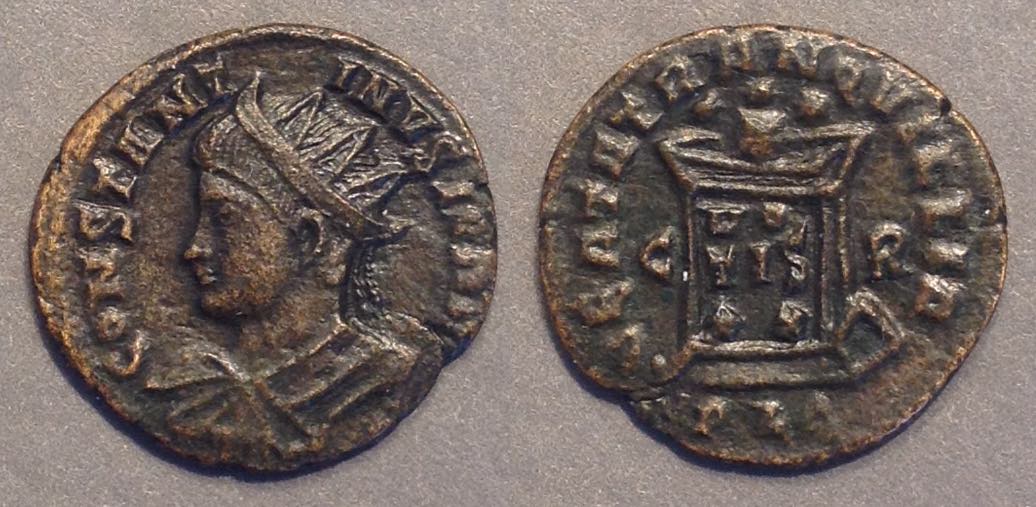 Constantine II, not Constantine.
Constantine II, not Constantine.
18 mm. 1.83 grams.
A well done ancient imitation, with some indications it is not official.
The end of the obverse legend is not right.
CONSTANT-INVS IVN C (the end is not clear)
Radiate bust left. The left-facing bust and youthful portrait suggest Constantine II.
BEATA TRANQVILLIA (again, the ending is not right)
Prototype similar to RIC VII Lyons p.130-4 "321-324" which have this mint and control mark, but not this legend break, legend, or bust and not this reverse legend ending.
VOT XX imitations

18 mm. 3.14 grams.
Clear and legible legends unknown on official issues.
CONSTA-NTINVS [No title! It usually ends AVG]
VOT
XX in wreath
CONSTANTINVS AVGG around [No initial "DN"]
PTR in exergue
There is a Trier VOT XX reverse, RIC Trier 439, but not with these legends.
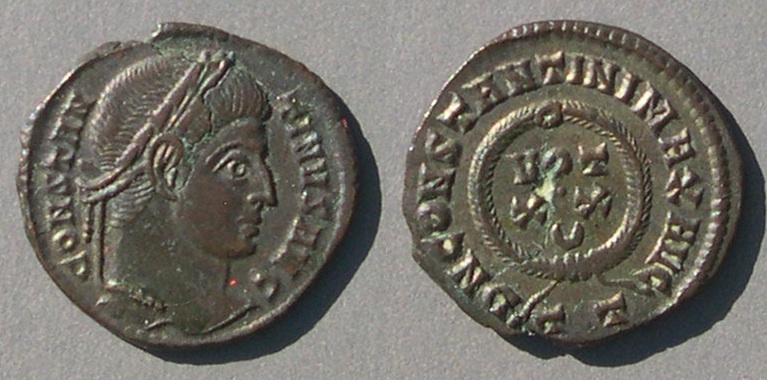 A similar official coin.
A similar official coin.
Constantine, 306-307-337
19 mm. 2.48 grams.
CONSTANTINVS AVG
VOT/XX/<crescent> in wreatth
DN CONSTANTINI MAX AVG
T T in exergue
RIC Ticinum 167
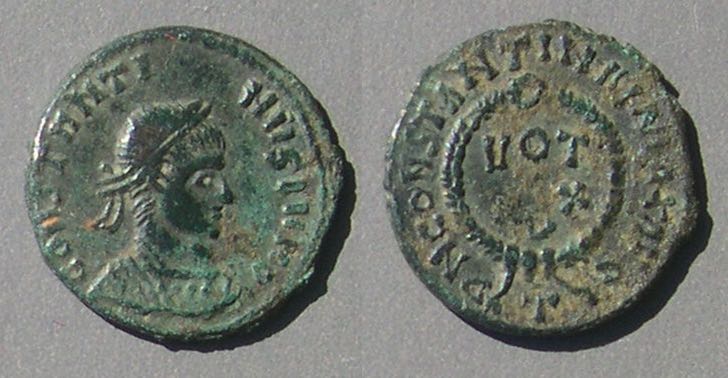
18 mm. 2.81 grams..
CONSTANTINVS ......
The portrait resembles Constantine II. The legend termination would make the distinction, but it is unclear. It would end "IVN NOB C" for Constantine II instead of "AVG" for Constantine. The reverse legend is distinctly of Constantine.
DN CONSTANTINI MAX AVG around,
VOT XX over crescent in wreath, T in exergue
"T" suggests Ticinum, but official issues from Ticinum have mintmark of form "PT".
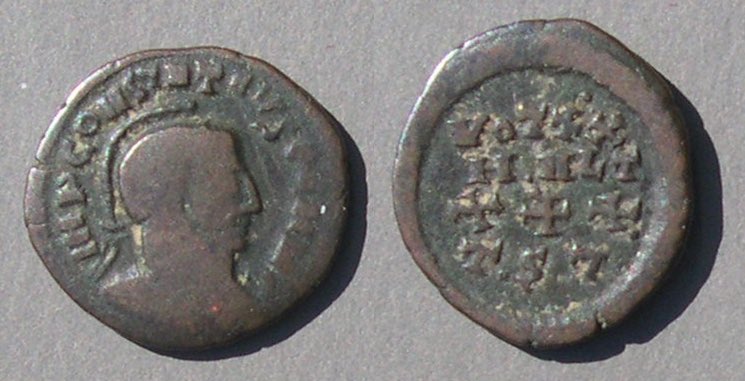 Constantine
Constantine
18 mm. 2.62 grams. 9:00.
Thessalonica mint type.
Bust right, with nearly correct letter forms.
IMP CONSTAT[sic]NVS PF AVG, helmeted bust right
VOT XX / MVLT / XXX T.S.Γ [backwards]
Prototype: RIC VII Thessalonica 28 "318-9"
 A similar official coin.
A similar official coin.
18 mm. 2.78 grams.
RIC VII Thessalonica 28
A similar reverse is below under Constantine II.
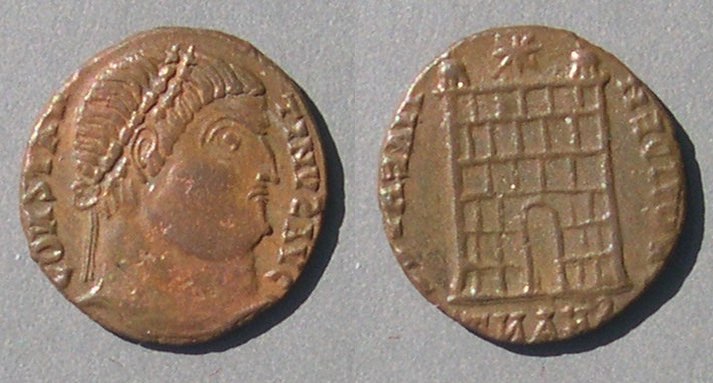 Constantine
Constantine
18 mm. 2.70 grams.
CONSTANTINVS AVG [bold letters retrograde]
laureate head right
Mirror image reverse. The reverse is completely retrograde!
PROVIDENTIAE AVGG retrograde around gampgate
SMANT retrograde in exergue
Eastern imitations are very rare. According to the reputable dealer from whom I obtained this one, it was the only imitation in a hoard of 20,000 pieces!
Lovely rust-colored patina
Prototype: RIC VII Antioch 63 or 78 "325-6, 326-7"
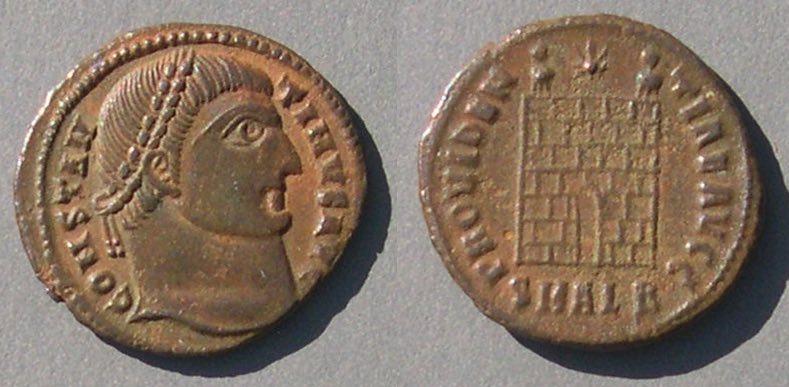 A similar official coin
A similar official coin
20-19 mm. 3.11 grams.
CONSTAN-TINVSAVG
PROVIDENTIAE AVGG around campgate
SMALB in exergue
RIC VII Alexandria 34 "325-6"
Similar lovely rust color!
A
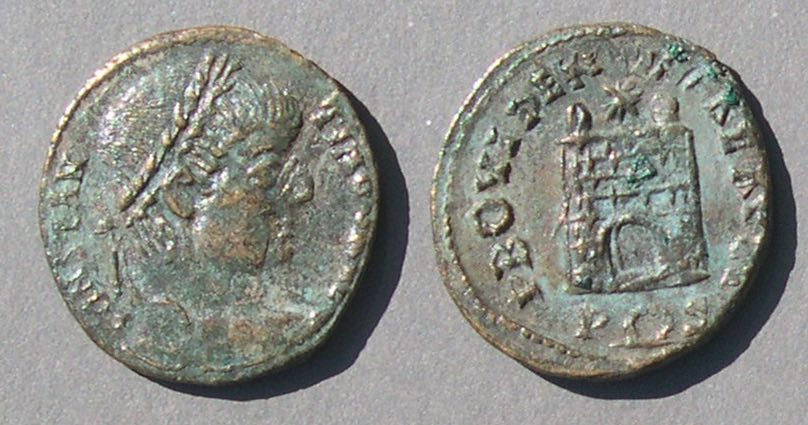 20 mm. Large! 3.61 grams.
20 mm. Large! 3.61 grams.
CONSTAN-TINVS AVG
PROVIDENTIAE AVGG around
campgate
P<wreath>S in exergue
Prototype: RIC VII Rome 287 "326"
VIRTVS EXERCITI imitation
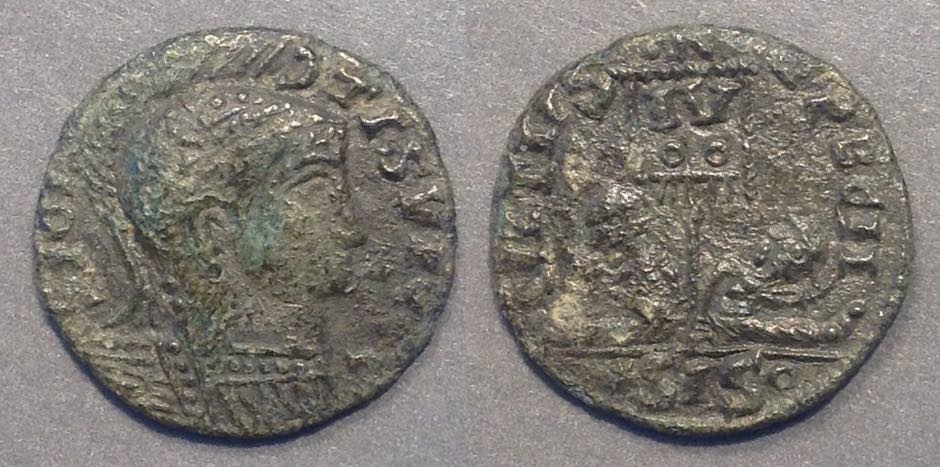 Constantine
Constantine
17-16 mm. 2.00 grams. Slightly smaller than the original (below).
Crude lettering and bust
Obverse legend with some letter-like forms including T, I, S, V
helmeted and curiassed bust right
Two captives at base of standard with "IV/oo" onit, •SIS• mintmark.
Prototype: VIRTVS EXRCITI type, two captives at base of standard, inscribed VOT/PR
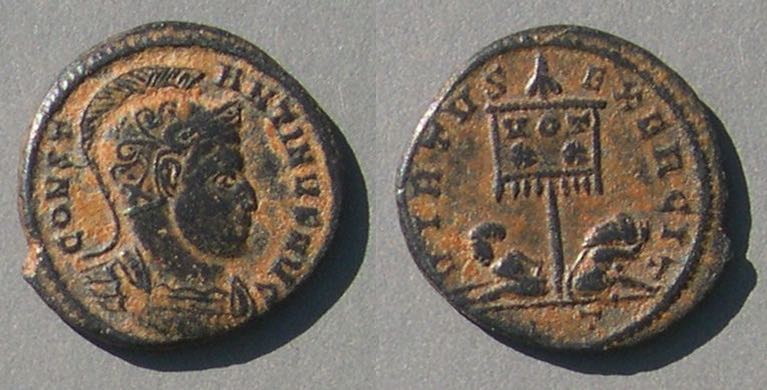 A similar official coin.
A similar official coin.
18 mm. 3.13 grams.
CONST-ANTINVS AVG
VIRTVS EXERCITI around
Standrad with
VOT/XX on banner
between two captives
PT in exergue
RIC VII Ticinum 114
Lovely black and tan patina
Crispus (317 - 326) imitations
 Crispus. 317-326.
Crispus. 317-326.
19-18 mm.
Slightly crude, but legible.
CRISPIIIS NOB CAES with some crude letters, bust left with spear forward and shield
VOT V in wreath, CAESARVM NOSTRORVM with some crude letters
Reverse double struck so a mint mark, if ever there, is not legible.
An official coin with this obverse and a VOT V reverse is next.
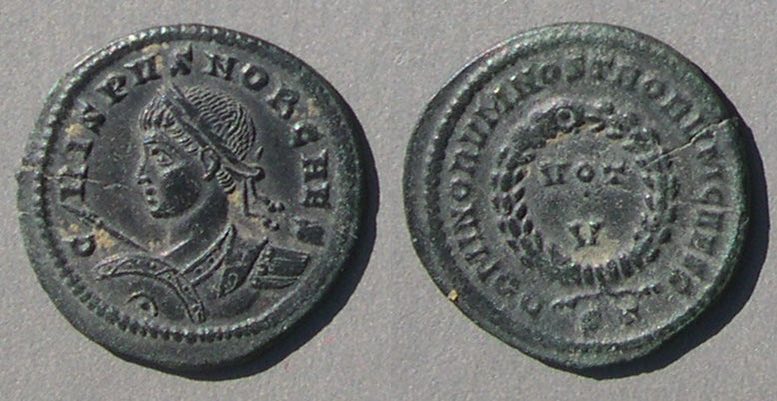 An official coin similar to the imitation above.
An official coin similar to the imitation above.
Crispus, official coin.
20 mm. 2.28 grams.
CRISPVS NOB CAES
VOT V in wreath, DOMINORVM NOSTRORVM CAESS
ST in exergue
RIC VII Ticinum 150 "320-321"
Four of the next six have reverse types suggesting "VOT XX" which is not a type of Crispus, rather Constantine. Nevertheless, the legend and bust left suggest the pieces imitate coins of Crispus. Why VOT XX is more popular than VOT X or VOT V, which are official legends for Crispus, is a mystery to me.
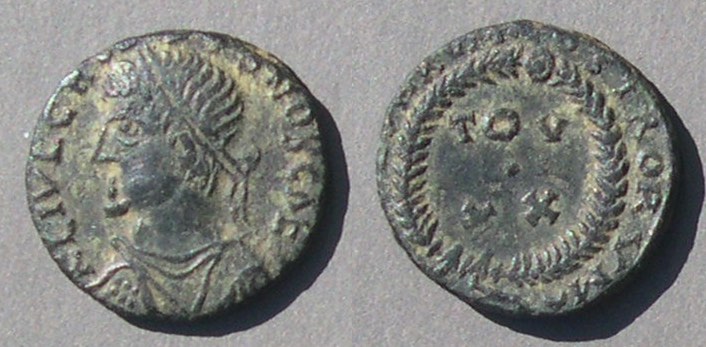 Crispus, 317-326
Crispus, 317-326
17 mm. 2.45 grams.
Reasonably legible
obverse: FL IVL CR..VS NOB CAE[S]
retrograde "VOT" so: /TOV XX in wreath,
.... STRORVM, first part off flan
/mint mark off flan
Prototype: VOT/XX in wreath, DOMINORVM NOSTRORVM around
an unlisted prototype, a combination of Lyon elements. An obverse legend of 319-320 and a reverse legend of 320 and VOT XX of 321 for Constantine. The reverse legend is also used 323-4.
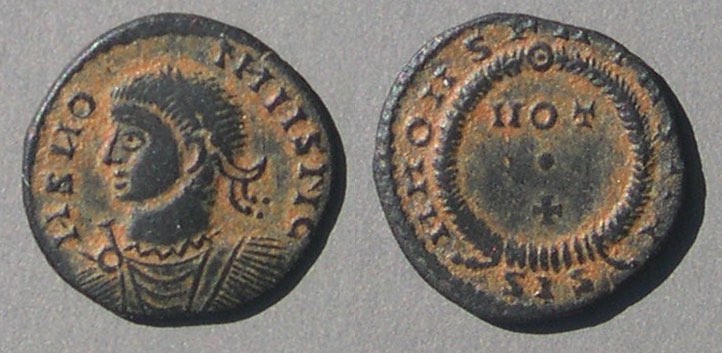 Crispus, 317-326
Crispus, 317-326
17 mm. 2.02 grams.
Various letter forms that do not make names, titles, or words.
but the type suggests if imitates a coin of Crispus
VOT
•
+ (a tilted "X")
SIS in exergue
Prototype RIC VII Siscia page 418, issue of 320-324.
A official coin with a similar type is next.
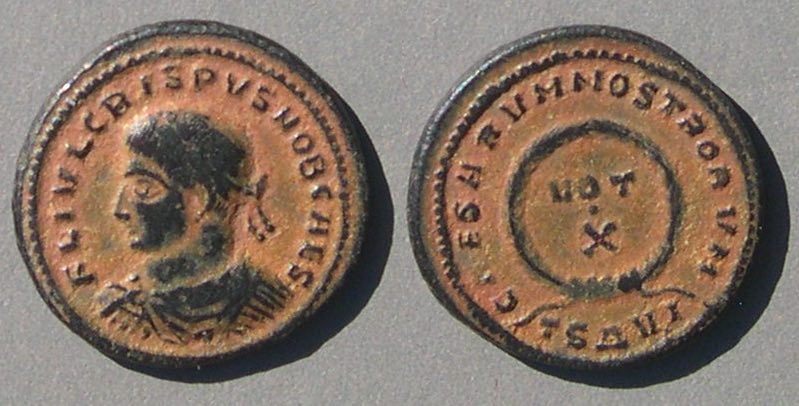 Crispus, official coin.
Crispus, official coin.
20 mm. 3.78 grams.
FL IVL CRISPVS NOB CAES
VOT
X in wreath
CAESARVM NOSTRORVM around
TSΔVI in exergue
RIC VII Thessalonica 125, struck 324
Left facing busts of Crispus are common -- more common than for his siblings. Although these legends usually cannot be read with enough certainty to identify Crispus by a legible name, the bust left strongly suggests a Crispus prototype.
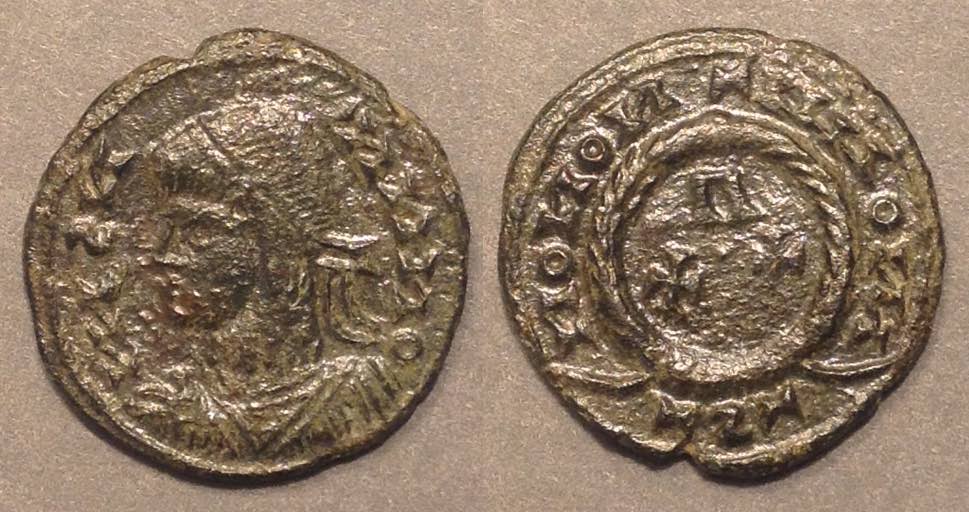 Crispus, 317-326
Crispus, 317-326
18 mm. 2.11 grams
This reverse type is common. The coin reminds me of Crispus, but he did not issue a vota piece with XX.
Left-facing bust, garbled legend of retrograde letters, mostly N's, with an S and an O
X X below crude upside down V, nonsense legend of retrograde letters, mostly N's and O's.
Exergue also illegible letter-like forms
Reverse prototype VOT XX inside wreath around which DOMINORVM NOSTRORVM or similar.
The dealer thought it was "possibly from Slovakia."
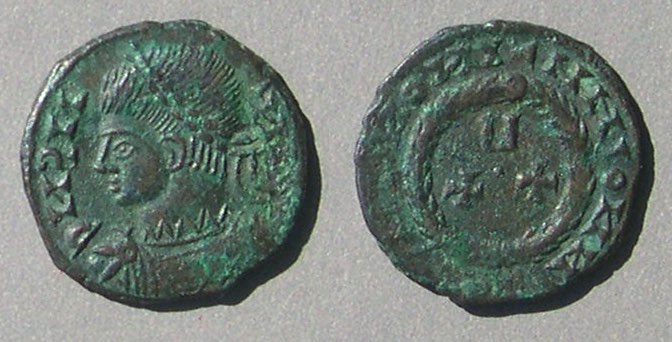 Crispus, 317-326
Crispus, 317-326
Another, similar, example, from different dies.
16 mm. 2.07 grams.
Crispus
Various letter forms that do not make names, titles, or words.
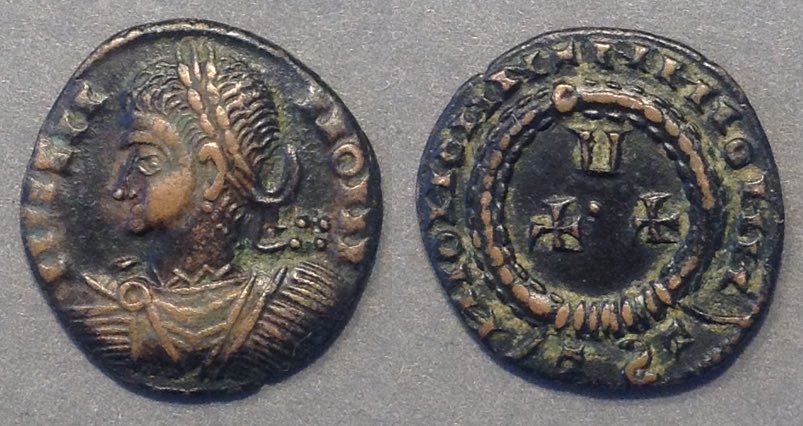 Crispus, 317-326
Crispus, 317-326
16 mm. 1.68 grams.
Letter-like forms. Shapes vaguely like
I I I S I I - N O I I I
Laureate, curiassed bust left.
N I O I I O L T A Y - I I I I I O I I I L
U
+ + (for X X)
Retrograde TSΓ in exergue
Probably imitating
DOMINORVM NOSTRORVM around
The three above are from different reverse dies, but have a lot in common.
Helena, Mother of Constantine, imitations
 Helena imitation.
Helena imitation.
12 mm. 1.26 grams.
Diademed bust of Helena right, ....LENA .....
PAX PVBLICA type
PA[X PVBLI]CA, Pax holding branch and transverse sceptre
TRS[dot] in exergue
Prototype: Sear 3810.
Bastien ANSMN 30 --, cf. FMRZ Lux II, plate VIII.2790 and FMRZ Lux I, plate XIII.3740-43, which are similar.
Its prototype is next.
 Helena, official
Helena, official
17-15 mm. (A little larger than many.) 1.61 grams.
Prototype here: FL IVL HE-LENAE AVG, Helena bust right in ornamental mantle and necklace
PAX PVBLICA •, Pax standing left holding branch and transvers sceptre
CONSЄ
RIC Constantinople 33, struck Sept. 337 - Spring 340.
 Hybrid. Helena/Victory reverse of CONSTANTINOPOLIS type.
Hybrid. Helena/Victory reverse of CONSTANTINOPOLIS type.
9-10 mm. 0.71 grams.
Found in the English midlands.
There are many tiny imitations that could not have fooled anybody and must have sserved as (very) small change. These irregular types made no pretense of looking official and often have obverse and reverse types that do not belong together.
Constantine II (Caesar 317 - 337, Augustus 337 - 340)
 Constantine II, 317-337-350
Constantine II, 317-337-350
15 mm. 1.48 grams.
An imitation of nearly official style, but small.
Anepigraphic obverse.
CONSTAN
TINVS
IVN NOB C
SMRT
RIC VII Rome 282 "326"
but the prototype is 2 mm larger. Only the small size makes me think this is unofficial. Is this official and simply small?
Found with three other anepigraphic imitations in a hoard of 8000 mostly GLORIA EXERCITVS coins. It fits their module.
Next is an official piece from Antioch.
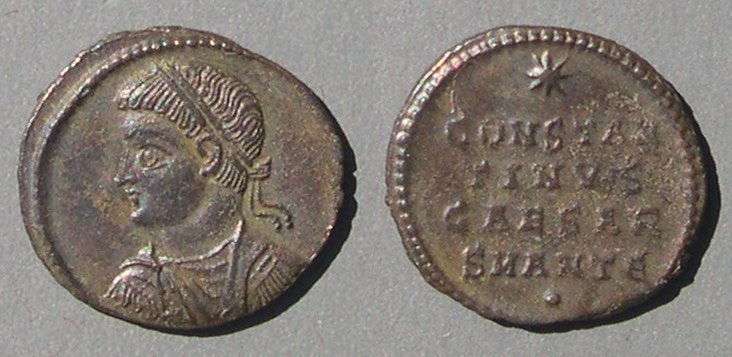 Constantine II as Caesar
Constantine II as Caesar
18 mm. 2.19 grams. Some dull surface-silver.
✳
CONSTAN
TINVS
CAESAR
SMANTE
•
RIC Antioch 59 of 324-5.
Antioch is, by far, the most common mint for anepigraphic coins of the family of Constantine.
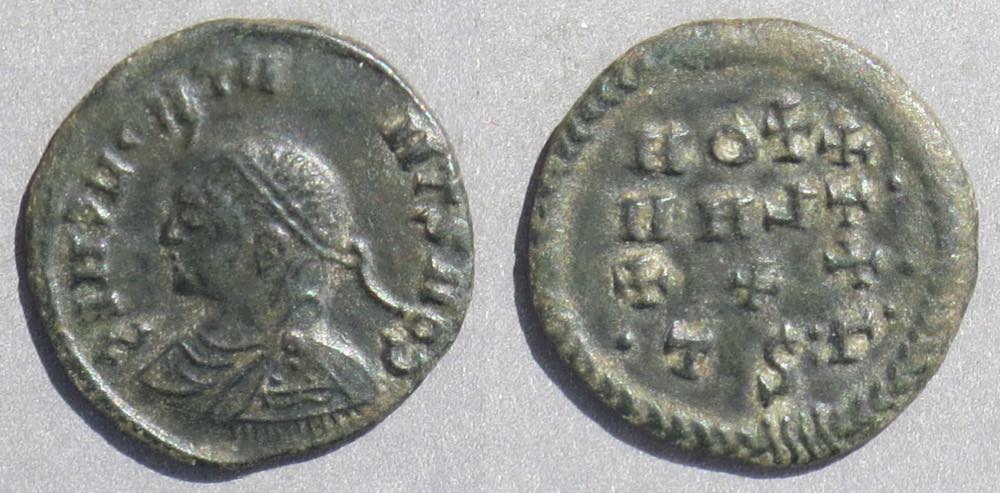 Constantine II imitation
Constantine II imitation
18-17 mm. 2.23 grams.
Laureate, draped, and cuirassed bust left
Legend reads outwards counterclockwise!
CONSTA-NTINVS CAES with some letters backwards or blundered.
[Possibly resembling CONSTANT NOB CAES, which is not an official legend]
VOXX (X's like crosses: +, with large serifs)
MHLT
X X X (X's like crosses: +, with large serifs)
•TS•Γ• in exergue.
Prototype: RIC VII Thessalonica 27-32 of Constantine, but no similar obverse legend. See plate 15.30 for the reverse prototype. RIC p. 504, AD 318-9. This obverse legend is retrograde and shortened for RIC 43-47 of Constantine II. This must be a hybrid of a Constantine II obverse and a Constantine I reverse.
Other
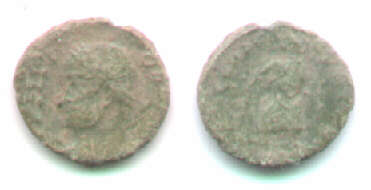 12 mm.
12 mm.
Bust left, looks like Constantine II/bulky standing figure
Very crude markings where the legend would be.
Found in the English midlands in 1996, with the typical English green patina/corrosion.
There are very many examples in very poor condition. Many of them are unidentifiable.
This is the end of the page on imitations that are not of commonly imitated types.
Go to pages on imitations of "Two Victories", GLORIA EXERCITVS, VRBS ROMA, or CONSTANTINOPLIS types.
Go to the page on imitations of types from 340-347.
Return to the main page on imitations of Roman coins.
Victor Clark has a page of similar imitations (off site in a new window): http://www.constantinethegreatcoins.com/barb2/
 A wonderful full-sized imitation
A wonderful full-sized imitation  A similar official coin.
A similar official coin.
 Constantine II, not Constantine.
Constantine II, not Constantine.
 A similar official coin.
A similar official coin.
 Constantine
Constantine A similar official coin.
A similar official coin. Constantine
Constantine A similar official coin
A similar official coin 20 mm. Large! 3.61 grams.
20 mm. Large! 3.61 grams. Constantine
Constantine A similar official coin.
A similar official coin. Crispus. 317-326.
Crispus. 317-326. An official coin similar to the imitation above.
An official coin similar to the imitation above.  Crispus, 317-326
Crispus, 317-326 Crispus, 317-326
Crispus, 317-326 Crispus, official coin.
Crispus, official coin. Crispus, 317-326
Crispus, 317-326 Crispus, 317-326
Crispus, 317-326 Crispus, 317-326
Crispus, 317-326 Helena imitation.
Helena imitation. Helena, official
Helena, official Hybrid. Helena/Victory reverse of CONSTANTINOPOLIS type.
Hybrid. Helena/Victory reverse of CONSTANTINOPOLIS type. Constantine II, 317-337-350
Constantine II, 317-337-350 Constantine II as Caesar
Constantine II as Caesar Constantine II imitation
Constantine II imitation